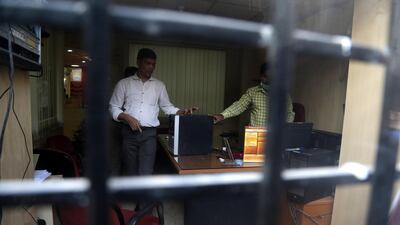Even as India’s state-owned banks reel from a multi-billion-dollar fraud perpetrated by two jewellery entrepreneurs, a fresh loan default case threatens to hit banks with a further $572 million loss.
On Monday, India’s Central Bureau of Investigation (CBI) opened an inquiry into the affairs of pen manufacturer Rotomac Pens and its chairman, Vikram Kothari, who borrowed funds from a consortium of seven government banks.
After Mr Kothari was declared a "wilful defaulter" by one of the banks, the CBI carried out surprise raids on his offices and homes on Monday morning. The chairman insisted that he would remain in his hometown of Kanpur and was "not running away anywhere", unlike Nirav Modi and Mehul Choksi, the nephew-uncle diamond barons who fled India last month after racking up at least $2.74 billion worth of bank credit that they could not afford.
Mr Modi and Mr Choksi fraudulently secured credit guarantees from a Mumbai branch of the state-run Punjab National Bank (PNB), which in turn helped them to secure credit from other Indian banks.
The two cases have grabbed headlines both in India and around the world. But in reality they represent only the tip of the iceberg when it comes to stressed loans held by Indian banks.
__________
Read more: India bank to close in South Africa amid Zuma controversy
__________
Last October, a Reuters review of data from India’s central bank revealed that banks in the country may be holding as much as $146bn in loans that are either failing to return interest payments, being restructured or have been written off.
The majority of these loans have been issued by state-owned banks “to large conglomerates, especially in steel and infrastructure”, the Reuters analysis revealed. Nineteen out of the 21 state-owned banks in India posted losses in the October-December financial quarter.
Government banks have been at the core of India's financial sector since they were first nationalised in 1969 — even after the economy was liberalised in 1991.
And apart from making loans to corporations, these banks “are also crucial in implementing the government’s social sector schemes”, says John Samuel Raja, the founder of How India Lives, a New Delhi-based public data analysis firm.
“For example, if the government announces a scheme by which a woman or a lower-caste entrepreneur can get cheap loans to start their own business, the state-run banks are the ones that offer such loans. Private banks wouldn’t touch loans on those terms, because they wouldn’t be profitable.”
This means that banks' dealings with private companies can negatively impact the government's social welfare programmes.
The stressed loans on the books of state-run banks piled up in part because of the financial slowdown since 2008, but also because of the institutions' poor scrutiny of borrowers. This lack of scrutiny may have been the result of either poor decision-making on the parts of banks or these banks yielding to crony capitalism, Mr Raja said.
“As a state bank, if the finance ministry is controlling your board, you are, in theory, vulnerable to pressure,” he said. “How many bank officials will have the guts to stand up to a call from up top, demanding that the bank loan out millions of rupees more to a borrower whose project is already in trouble?”
In October, Prime Minister Narendra Modi’s government announced a plan to inject $32bn into the veins of the state-owned banks to recapitalise them. In the 11 years prior to that, successive governments had already pumped roughly $40bn into the same institutions.
Mr Raja said that any money the government pours directly into banks’ coffers will widen the country’s fiscal deficit.
And the cost of keeping these banks afloat has prompted calls for the government to sell them off or at least to reduce their shareholdings in them.
On Saturday, Arvind Subramanian, the prime minister’s chief economic adviser, said the government would do well to cut its stake in these banks.
“We need to recognise how much stress there is in the banking system,” he said. “Bank of Baroda closed down its South Africa operations [following an investigation into alleged fraudulent dealings] and now PNB is facing problems.”
State ownership handicaps banks, impairing their decision-making processes and influencing recruitment, he added. “We need to relieve them of that.”

